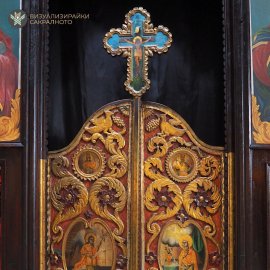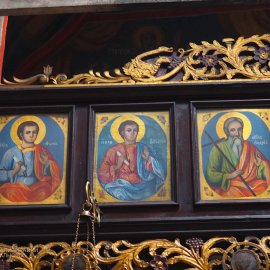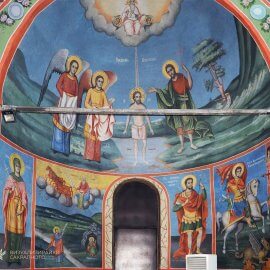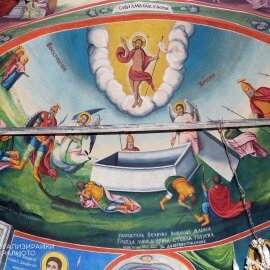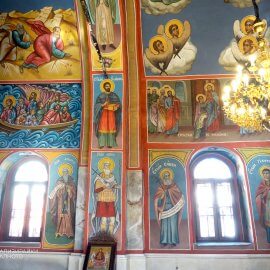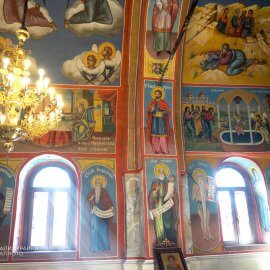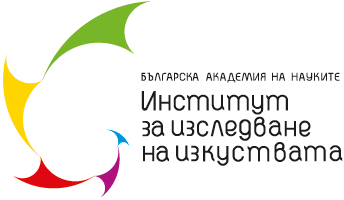Basic information
Born: about 1840 (village of Galičnik, North Macedonia)
Died: 20 July (?) 1888 (village of Galičnik, North Macedonia)
Painting in the churches of Sofia
- 1883 – Church of Theotokos Zoodochos Pege [Holy Mother of God Life-Giving Spring], Poduyane district – apostolic icons, royal doors, paintings on the crucifix from the acroterion;
- 1888 – Church of Theotokos Zoodochos Pege, Poduyane district – murals;
State of research
The first one who have considered the activity of Evgeni pop Kuzmanov is Asen Vasiliev 1Vasiliev 1965: 186, 228-229. . In his opinion in all of his creative work the Debar icon-painter attempted to resemble the style of Dicho Zograf, however without managing to achieve the same success and popularity 2Vasiliev 1965: 228.. Some new data about the work of Evgeni pop Kuzmanov in the Eparchy of Vidin has been published over the past years by a team of researchers from the Institute of Art Studies at the Bulgarian Academy of Sciences3Gergova, Genova, Vanev, Zaharieva 2017: 15, 31, 38, 47, 61, 62, 158; Gergova, Vanev, Zaharieva, Boykina 2021: 9, 86, 88, 94, 96, 108, 110, 178, 230, 231.. The iconographic characteristics of the murals in the Church of St. George in the village of Deleyna (Province of Vidin) made by Evgeni pop Kuzmanov jointly with the icon-painter Alekso Vasilev were examined by D. Boykina4Бойкина 2019., and the work of the icon-painter in the Church of Theotokos Zoodochos Pege in Sofia was analyzed by V. Yoncheva5Yoncheva 2021: 51-62..
Biography
Evgeni pop Kuzmanov was born about 1840 in the village of Galičnik, North Macedonia. He comes from the Pulevtsi family of icon-painters. It is known that about 1869 he left Macedonia and came to work in Northwestern Bulgaria6Gergova, Genova, Vanev, Zaharieva2017: 231..
In 1865, he painted the iconostasis icons for the Church of the Holy Mother of God in the villahe of Bregovo, Province of Vidin7Vasiliev 1965: 229.. A. Vasiliev discovered an icon made by him in 1869 depicting St. George in the Church of St. Nicholas in the village of Gradets8Vasiliev 1965: 228.. Evgeni pop Kuzmanov also painted some icons in the Church of the Holy Apostles Peter and Paul in the town of Kula9С изключение на три царски икони: Богородица с Младнеца, Христос и Архангел Михаил, работени от Дичо зограф, всички останали иконостасни икони са дело на Евгени поп Кузманов. Виж Василиев 1965: 186.. In the following years the icon-painter continued to work on the territory of the Eparchy of Vidin by painting icons for the Church of the Holy Trinity in the village of Boynitsa (1871)10Gergova, Genova, Vanev, Zaharieva 2017: 31; Gergova 2015: 47., the entire painting work for the iconostasis, icons for the proskinetarion and a crucifix behind the throne for the Church of the Holy Apostles Peter and Paul in the village of Mayor Uzunovo (1879–1880)11Gergova 2021: 110-117. , a gonfalon and icons for the Church of the Holy Trinity in the village of Koshava (1879)12Vanev, Zaharieva 2021: 94., icons and murals for the Church of St. Nicholas in the village of Vrav (1880)13Gergova, Genova, Vanev, Zaharieva 2017: 31., an icon for the proskinetarion in the Church of the Ascension of Christ in the village of Kudelin (1881)14Boykina 2021: 96. It is assumed that the murals in the church were also made by him. See Boykina 2021: 97., icons and a gonfalon for the Church of the Holy Trinity in the village of Tiyanovtsi (1881)15Gergova 2021а: 181., icons for the Church of the Assumption in the village of Yasen (1883)16Gergova, Genova, Vanev, Zaharieva 2017: 61, 62., icons for the Church of St. Theodore Tyron in Vidin (1885)17Gergova, Genova, Vanev, Zaharieva 2017: 15., royal doors and murals for the Church of St. George in the village of Deleyna (1885)18Boykina 2019; Boykina 2021а: 86, 88. , murals and icons for the Church of Prophet Elias in the village of Kovilovo, Serbia (1887)19Kostiћ 2012: 103-110; Gergova, Genova, Vanev, Zaharieva 2017: 16; Boykina 2019; Gergova, Vanev, Zaharieva, Boykina 2021: 231..
It is known that in the end of his life the icon-painter returned to Galičnik where he died on 20 July 188820Vasiliev 1965: 228, 229.. However, an inscription from the south concha of the Church of Theotokos Zoodochos Pege in Sofia casts doubt upon that date. The inscription makes clear that the murals made by Evgeni pop Kuzmanov were completed on 18 July 1888. The difference of just two days between the painting of the church in Poduyane and the date of the icon-painter’s death is notable. Taking into consideration that A. Vasiliev explicitly notes that Evgeni pop Kuzmanov died in the village of his birth it seems quite unlikely that he finished his work in Poduyane and then traveled the distance of 350 km to die in Galičnik just two days after that. Logically, one can suspect that the date of the icon-painter’s death is wrong and he died later than 20 July 1888. And yet the existence of something even less likely should also be noted. The murals in the Church of Theotokos Zoodochos Pege might have been completed by some of the associates of the icon-painter. It is known that in his work he teamed up with other icon-painters, among which are Nikola Yanovili and Aleko Vasilev21Vasiliev 1965: 229. but their contribution to the performance of the commissions is not clarified22Yoncheva 2021: 58..
Painting in the churches of Sofia
For the Church of Theotokos Zoodochos Pege in Poduyane Evgeni pop Kuzmanov made the apostolic icons from the iconostasis, the painting on the crucifix from the acroterion and the royal doors as well as the murals23Yoncheva 2021: 57-60..
The icon-painter commenced his work on the artistic layout of the church as early as in 1883, the year the royal doors and the painting on the acroterion date from24Yoncheva 2021: 57.. The royal doors and the curve-piece are wood-carved, the doors are crowned with a pictorial crucifix. In the bottom register as well as in the curve-piece there are crowned lions shaped in a low relief, a heraldic motif, most likely influenced by the state Coat of Arms. In the second register of the doors the scene of Annunciation is presented in plastic-framed medallions. There is a later donor’s inscription in the left part of the medallion with a depiction of Archangel Gabriel25The inscription reads: “Paid by Georgi Bozhilov, Mladenka Geleva to Bel Hristo Stanika.”. Underneath the medallion with a depiction of the Mother of God the year 1883 is shaped in a relief, i.e. the doors were most likely made then. In the uppermost register of the winds in the medallions are depicted the Old Testament kings David and Solomon. The painting on the royal doors is stylistically very close to the one on the doors of the iconostasis of the Church of St. Nicholas in the village of Vrav made by the same icon-painter26Gergova, Genova, Vanev, Zaharieva 2017: 38, 47..
The trellis vine above the majesty icons is plastically designed by means of stylized plant motifs as medallions are shaped in between with depictions of Old Testament kings.
The Apostles tier presents waist-high depictions of the figures of thirteen apostles. From north to south: St. Thomas, St. Bartholomew, St. Andrew, St. Matthew, St. Luke, St. Peter, St. Paul, St. Mark, St. John, St. Jacob, St. Simon, St. Philip, St Matthias and Christ Pantocrator in the centre of the tier. The icon of Pantocrator is dated 1883 and has a ktetor’s inscription in its bottom. Most of the images have their exact parallels in the apostolic icons from the Church of St. Nicholas in the village of Vrav27Yoncheva 2021: 57.. Above the Apostles tier, in the central part of the iconostasis, is presented the Last Supper flanked by curve-pieces with wood-carved trellis vines.
The acroterion consists of a crucifix with two ripidiae with depictions of the Mother of God and St. John the Apostle. All three elements are framed by clairvoyée wood-carving frame. The painting on the crucifix was also made by Evgeni pop Kuzmanov. In its bottom there is a ktetor’s inscription dated 1883. On the two ripidiae there is contemporary painting.
The church’s murals were painted in several periods. The initial painting of the murals was made 188828In the documentation for the restroration of the murals kept at the church this first mural decoration is dated 1933. However, the inscription in the south concha shows that that painting occurred in 1888., the second stage was made in 1933. The most recent was made in 1989–2002.
The earliest mural decoration preserved in the apsis, the two conchae, the pendentives of the dome, the first and part of the second register on the north and south walls29In the second register on the northern wall the only later scene is Jesus Calming the Storm, and in the second register on the southern wall: Healing the Paralytic. as well as in some places on the vault of the church was made by Evgeni pop Kuzmanov30Yoncheva 2021: 58-60.. The ktetor’s inscription in the south concha makes it clear that the painting was completed on 18 July 1888.
In the first register of the apsis there are depictions of: St. John Chrysostom, St. Gregory of Nazianzus and St. Athanasius of Alexandria painted to the north of the apsis window; St. Romanos the Melodist and St. Stephen the Archdeacon – on both sides into the thick of the window; St. Basil the Great, St. Nicholas and St. Spyridon – to the south of the apsis window31The mural decoration in the apsis area is described based on the documentation for the restroration of the murals made available by the priest of the church as well as based on photographs also made by the priest of the church.. Above them is the Holy Mother of God, Wider than the Heavens [Platytera ton Ouranon] with two angels on each side holding scrolls. In the first register on the eastern wall, to the north of the apsis, is depicted St. Peter of Alexandria and above him is depicted John the Baptist. In the first register to the south of the apsis is depicted St. Gregory the Dialogist, and above him: prophet Amos. In the third register on the eastern wall is depicted the scene of the Annunication.
In the first register on the northern wall in the altar is depicted the scene of the Old Testament Trinity and the Annunication to Zacharias is painted above it. On the vault in a medallion there is a depiction of the Holy Trinity and four cherubim. The image is framed on both sides by friezes of plant ornaments. In the first register on the southern wall there are full-length depictions of St. Simeon Stylites, St. James, brother of the Lord and St. Theophanes the Confessor. In the second tier there are waist-high depictions of the righteous men Toviah, Melchizedek, Job and above them is the scene of the Entry into Jerusalem. In the first arch in front of the altar there are standing figures of prophet Micah and prophet Nahum.
In the pendentives of the dome are depicted the Evangelists with their symbols. The images are very close in stylistic terms to the ones from the crucifix of the iconostasis acroterion.
In the first register of the south concha (from east to west) are depicted St. John of Rila Wonder-Worker, St. Demetrius Myroblyte and St. Andrew Stratelates and St. Gurias depicted as a warrior, St. Procopius and St. Minas (to the wets of the window). In the second register is the scene of the Resurrection of Christ as in the bottom there is a ktetor’s inscription: “Paid by Velichko Yovanchov Aleksa / Grozda Minka Erina Stoila, Giorgia / 18th day of July in the year 1888 for the salvation of the soul.”
In the first register on the southern wall are depicted the standing saints: St. Serafim of Sarov, St. Anthony, St. John Climacus and St. Pachomius (into the thick of the window), St. Euthymius, St. Stylianos, St. Onuphrius, St. Eupraxia and St. Theodora (into the thick of the window), St. Peter the Athonite. In the second register on the same wall are depicted the scene of the Supper at Emmaus and St. Holy Unmercenary Cyrus. In the third register, above St. Cyrus, there is a depiction of St. Matrona.
In the first register on the northern wall are depicted standing saints (from west to east): St. Charalambos, St. Spyridon, St. Demetrius of Besarbovo, St. Theodosius, St. Minas, St. Sava, St. Maximus the Confessor and St. Paraskeva (into the thick of the window), St. Pantaleon and St. Tryphon. In the second register are depicted the Holy Unmercenary John and the scene of the Incredulity of Thomas. In the third register, above the depiction of St. John is presented St. Pelagia.
In the first register of the north concha (from west to east) are depicted the images of St. Anne, full-length, and the Ascension of Prophet Elias (to the west of the window) followed by a depiction of St. Theodore Tyron and St. George on a horse (to the eats of the window). In the second register is depicted the scene of the Baptism of Jesus.
It could be noted that some saints from the 1888 murals have their exact parallels in other churches painted by Evgeni pop Kuzmanov. Such is the case of St. George on a horse from the north concha of the church in Poduyane and the saint of the same name from the iconostasis of the St. Nicholas in the village of Vrav. The depictions of St. Demetrius from the northern wall of the church in Poduyane, from the southern wall of the naos of the Church of St. Nicholas in the village of Vrav and the one from the southern wall of the Church of St. George in the village of Deleyna are also analogous. The scene of the Ascension of the Prophet Elias depicted in the north concha of the church in Poduyane is almost identical to the one on the northern wall of the church in the village of Vrav. The case of St. Theodore Tyron from the north concha of the Church of Theotokos Zoodochos Pege and from the northern wall of the naos of the church in the village of Vrav is the same.
Vesselina Yontcheva

